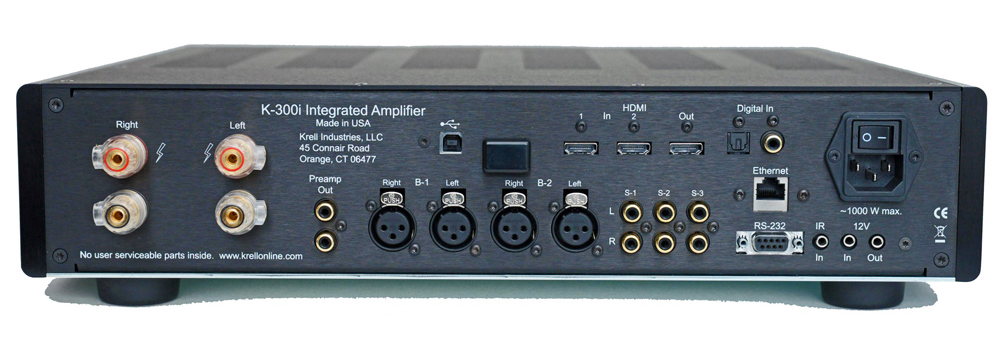You’ve seen it many times in the movies. A prodigal son, or a lone cowboy, or a legendary warrior returns from what was really a self-inflicted exile. A long time ago he was the best, but something happened and he lost his way for a while. Now he’s with us again. Everyone cheers, hats fly into the air and an old friend throws a welcoming arm around his shoulders and in a soft, moving voice says: “Welcome back!” Enter Krell’s new high-tech K-300i integrated amplifier.
Appearance + Features
That was exactly the impression I had after listening to Krell’s K-300i for five minutes and it hasn’t left me since. It was also a reminder that people like me spend so much of their precious time on this planet obsessing over Hi-Fi because it’s a genuine and unique opportunity to personally enjoy real works of art, either through their almost supernatural looks or through “being there”, when everything works properly, speakers disappear and you’re transported into the music venue, wherever and whenever that may be.
The K-300i impresses you right from the start with its commanding presence, especially in the “I’m the boss” black. Gone are the showy features of the days past, now Krell can justly claim that it has really made a work of art. K-300i achieves a unique blend of sturdiness and elegance because it oozes build quality no matter where you look or touch and then combines it with an understated curved front, unobtrusive display and neatly arranged controls. This work of art also has a lot of gravitas. Literally. Many amplifiers may be larger and heavier than K-300i but quite a few contain a lot of empty space for a number of very valid reasons. Not this one. It’s jam-packed with hardware and when you peek through its cooling slots you can’t see many empty spaces at all. When you lift the densely packed amplifier you might even wonder if it really needs to be plugged into the wall at all (“…there must be a nuclear reactor in there somewhere…”).

Although it’s nominally a Class-A amplifier using Krell’s proprietary ‘iBias’ circuitry, the K-300i dissipates surprisingly little heat for its stated power (150 watts per channel at 8 ohms and 300 watts per channel at 4 ohms). Krell specifies that just about two inches of free space above the amplifier are required to assure proper cooling. I’ve put K-300i to the test on this and it passed with flying colours, which means that you should be fine to install it in places where many other amplifiers of similar power would be out of the question solely because of their ventilation requirements. Neat.
The unit received for review came with a ‘Digital Module’ option, which means that, in addition to the usual analogue inputs, it also had a whole gamut of digital inputs to which you’re able to connect your sources, such as CD/DVD/BR players, streamers, USB keys and whatever the never-sleeping electronics inventors come up with next. Digital inputs include USB, optical, coax S/PDIF, HDMI and the ubiquitous RJ-45 Ethernet port. Of course, in order to decode all this wealth of digital signals, the Digital Module includes an ESS Sabre Pro DAC of impressive specifications. Lastly, the Digital Module has Bluetooth connectivity, which does come in handy sometimes, especially if you’re having a party and/or if you want to play with the frequency response (given Bluetooth’s limitations, although on-board aptX is getting there). All input ports except for one USB are at the back of the amplifier, organised in a tidy logical manner and easy to access and work with. So are the stream of analogue inputs (XLR and RCA) and speaker posts, which accept banana plugs and spades.
Convenience is everything these days. People expect to have their music available to them everywhere and anywhere, anytime while being able to connect any device to any other in two seconds flat. K-300i does not disappoint in this regard. It comes Roon-ready, MQA-capable and with a number of options for many popular streaming services, including Tidal and Spotify, which you can control through the ‘mconnect/mcontrol’ app on your handheld device of choice (Android and iOS versions). This is where I found that K-300i behaves differently to my Oppo BDP-105 player, because the presence of the handheld (phone or tablet) and the running of the app is essential for K-300i’s streaming. For example, if you flick the control app off the screen the streaming stops. If I do the same thing with Oppo’s controlling app, the streaming is not affected at all. However, as long as the handheld is there and so is the app, K-300i’s streaming works just fine. Just remember not to take the phone with you when somebody sends you to check on the front gate during a party…

K-300i’s network setup is easy and as straightforward as it comes. In my case, everything worked right out of the box with no problems at all. That said, please keep in mind that K-300i has two IP addresses: one for the control app and one for the web interface. When I scanned my network, I found one “Krell K-300i” device on the address 192.168.0.34 and one “Generic” device on the 192.168.0.75 address. When you open the settings of the control app, it shows the address ending with “34”. However, when you check K-300i’s front display, the address it shows is the one that ends with “75”. If you put the latter address into your web browser, you’ll connect to K-300i’s web interface that looks exactly like the front of the amplifier and you can control it just as if you were pressing the buttons on the amp itself. Some might prefer this kind of access, but by the time I discovered it I was already perfectly fine with Krell’s remote control which did everything I needed. At some stage, Krell might find a way to combine the two IP addresses into one, but the current situation of having two addresses is not a problem at all, as long as you know that there are two of them.
K-300i also has a HDMI output, which quite a few devices I encountered use for displaying their interface on a TV, but Krell decided not to include that feature in their current firmware. I hope they will be able to do it at some stage because the small display at the front, although supporting the elegant looks of the amplifier, might require some squinting for people whose eyesight is not 20/20.
I consider all of these as very minor quirks and they did not stop me in enjoying the great sound and great streaming that K-300i was delivering in spades.
Listening Impressions
For quite a while this review was in danger to be a very short one indeed, because in essence all I can say is that K-300i’s command of the sound is absolute. Period! And there is another thing which I never expected to encounter, and somewhere deep down it pains me to admit it, but K-300i sounds better than the power amplifier I designed, assembled, customised and tweaked over the years to suit my Magnepan speakers perfectly, or so I thought.
Now, before you say “…but Magnepans have no bass” or “…but Magnepans have no dynamics”, please let me counter both myths with “Magnepans have to be placed properly”. My listening room is just 4m x 3.7m and has some irregular features, which did present a challenge, but after spending a few weeks moving speakers around (yes, weeks, because panel speakers radiate both front and back and with Magnepans millimetres count) what was achieved has been a veritable acoustic nirvana in which a great recording rewards you with a front seat performance that’s barely distinguishable from the real thing. Bass, mids, highs, dynamics, soundstage, you name it – they’re all first class. Weeks were spent, but that was years ago and I never had to change the position of my speakers again. Sheer bliss!
Enter K-300i, “stage left”, as a distinguished guest who you’re happy to entertain for a while but you’re not sure what to expect from. The trouble begins when you realise that Krell managed to deliver value for your $12,000 and that the sound that’s coming out of K-300i elevates your speakers, especially Magnepans, to another level of existence altogether...
The sound quality I heard is more than just about THD, frequency curves and similar technical stuff. According to the theory, a power amplifier is supposed to perform one deceptively simple function: take a signal from the input and reproduce it faithfully amplified at the output. An integrated amp like K-300i performs two more functions: input selection and volume control. On paper, that’s all there is to it, but hi-fi industry has been living off the details since inception. I don’t care for amplifier topologies, valves versus silicon, passive-versus-active or any fashions and fads abounding the hi-fi world, as long as the produced sound is reproduced faithfully and accurately. In my view, any manufacturer, including Krell, has a legitimate right to claim their fair share of acronyms – and they’re welcome to it – but for me K-300i sweeps all those details aside with its marvellously accurate sound that you can never hear enough of and that you never get tired of.
As far as I could hear, Magnepans really appreciate the power and the high current capability of K-300i, as well as its tight control of speakers. In regards to speaker control, you have to keep in mind that speakers often impose a rather peculiar load on an amplifier because mechanical movements of the membrane and/or cone manifest themselves not only as resistance, inductance and capacitance loads but also as delayed current/voltage sources, all of which complicate the lives of Hi-Fi equipment designers. K-300i performs superbly in this regard, in a way that’s more than just about the damping factor. This is quintessential Quality with capital Q. Recordings that used to sound great suddenly reveal another layer of detail and you get a feeling that the speakers are much more obediently following the amplifier’s signal.

I’d recommend that you audition K-300i with its Digital Module installed because if you’ve ‘gone streamin’’, that might be all you’ll need in the foreseeable future. It incorporates a top-quality DAC and that it lets you utilise a wide variety of streaming services. For music that is not on your streaming service you will need other sources (CD/DVD/BR/TT/R2R…). For this review, I mostly used Tidal, which I’ve been subscribed to for a while and found to be the best fit for my needs.
I also tried K-300i with Redefy Audio Monitors with results very similar to what I heard with Magnepans. I’m sure that K-300i would have handled many other speakers just as well as these two. If your speakers’ main virtue is accuracy, I’m certain that K-300i will reveal their full potential to you. It definitely did it for me.
I have a fairly standard set of test tracks that I use for evaluating equipment. This set reliably reveals strong and weak points of any device in the chain, but in the case of K-300i it was very hard indeed for me to find anything that would require an improvement to what I heard. Then, I expanded the repertoire and tried more and more tracks, but still could not find any weak points. Well, maybe, if your speakers need only 15-20 watts to fill the room with music, you may want to find them a suitably powered amplifier, perhaps a valve-based one. If, however, your speakers love a bit more power and can use additional current – again, if they’re Magnepans – I’d go straight for the K-300i and never look back.
Please let me elaborate on this point a bit.
The K-300i made it literally uncanny to listen to Anette Askvik’s “Liberty”, from the album of the same name, because it clearly revealed the singer’s articulation sounds: mouth opening, breath taking and every movement of her tongue and lips. I did hear them quite clearly before I plugged K-300i into the chain, but this was something entirely different. Another example would be Osibisa’s “Kolomashie”, album Welcome Home, which somehow acquired another layer of African village sounds, while singing and clapping of the performers gained immediacy that I previously thought was not possible. Come to think of it, try Osibisa’s “Seaside Meditation” as well. (I heard it performed live ages ago and the drum extravaganza in the middle of the song lasted 11 minutes flat! It’s still with me…)

Next, I tried Yello’s “Takla Makan”, album Touch Yello (Deluxe). As the name of the album suggests, the sound makes you feel that you can almost touch the sands of the Takla Makan desert. Watch for the sound of the didgeridoo about 50 seconds into the recording. It gives you a jolt!
When testing, I always try a wide variety of recordings and then let a device “drift” towards its preferred genre of music. In this case, K-300i remained right in its original “United Nations” position and faithfully amplified whatever it was ordered to. For example, when playing classical recordings such as “Jupiter” from Holst: The Planets by Boston Symphony Orchestra, conductor William Steinberg, the orchestra was there, from double basses all the way to the tiny triangle. You could hear cymbals crashing with the same measure of clarity and mellowness as when you hear them live, with no harsh edges anywhere. The next case in point for me was Schubert’s String Quintet (D956), where K-300i effortlessly confirmed the technical brilliance of the performers and the recording made by the Artemis Quartet (with Truls Mørk; Virgin Classics), versus a much more flowery version recorded by the Melos Quartet with Mstislav Rostropovich for Deutsche Grammophon.
As mentioned before, K-300i will make a great recording reward you with a front seat in the venue. The best example of this for me was VH1 Storytellers live album by Johnny Cash and Willie Nelson, which was recorded with just a few microphones in close proximity to the audience. I even played track 1 “Ghost Riders in the Sky” to some people who are admittedly not very particular to country music, but they were nonetheless captivated by the quality of the sound. They asked me to play it again!
Jazz albums, like Crystal Silence Chick Corea and Gary Burton, and Flood by Herbie Hancock benefited greatly from K-300i’s accuracy and dynamics. Flood in its original form is a relatively hissy recording (have a listen to “Butterfly” for the best example; maybe the tapes were not up to scratch), but K-300i reproduces that hiss without making it a distraction. At the same time, the highs are not compromised at all. Whatever is the trick, it has my vote.

Lastly, I put on Donald Fagen’s The Nightfly and, to my great pleasure, K-300i (in cooperation with Tidal) revealed that it was MQA (Master Quality Authenticated). This added yet another layer of richness to the sound and made me run out of words to describe the end result. Please listen to The Nightfly but be careful because I’m sure that anyone who hears this recording through the setup I described will immediately feel an overwhelming urge to acquire K-300i and never mind the price. As for myself, I had to perform a desensitisation exercise reminiscent of a scene from Some Like It Hot by repeating to myself: “I’m on a budget. I’m on a budget…” before I parted with this marvellous amplifier, particularly because of its delivery of The Nightfly.
Conclusion
Yes, it is in the upper price bracket. On the other hand, when will I own a Picasso painting? K-300i is a work of art, and moreover, a work of art that makes you enjoy other works of art in a truly breathtaking way. Imagine if painters made great paintings for centuries but kept them under a veil that only hinted at their true beauty. Suddenly somebody comes around and pulls the veil away and lets you see the paintings in their full glory, every stroke of the brush and every speck of paint. K-300i did that for me for the music. Get it if you can.
…Vedran Simunovic
www.soundstageaustralia.com
Associated Equipment
- Speakers — Magnepan MMG, Redefy Audio Monitors (on loan)
- Amplifier— Krell K-300i
- Sources — Digital: Oppo BDP-105AU; Analogue: Linn Sondek LP12 turntable, Hercules power supply, Grace 707 tonearm (modified), Dynavector 10X5 cartridge
- Cables — Interconnects: Custom made; Speaker cables: BelkinPureAV (AV53001-12)
- Subwoofer — Anthony Gallo MPS-150 subwoofer amplifier with custom 12 inch driver
Krell K-300i Integrated Amplifier
Price: AU$9999; AU$11,999 with Digital Module
Warranty: Five Years
Australian Distributor: Audio Marketing
+61 2 9882 3877
www.audiomarketing.com.au
Krell Industries, LLC
45 Connair Road
Orange, CT 06477-3650
USA
+1 203 799 9954
www.krellonline.com











